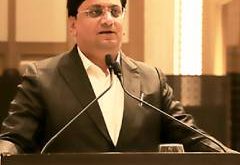One of the earliest adopters of SAP, and as a company that runs Asia ‘s largest factory in Rampur, getting everyone on the same page for the  newer technology implementations was critical for Farhan Khan, Vice President, IT, Radico Khaitan. When he set himself the task for ensuring cost optimization using IT, the road was uphill, but now its success all the way.
newer technology implementations was critical for Farhan Khan, Vice President, IT, Radico Khaitan. When he set himself the task for ensuring cost optimization using IT, the road was uphill, but now its success all the way.
Here in conversation with…….
- What brought you at Radico? What is your role and responsibilities at Radico Khaitan?
Radico was one of the earliest adopters of SAP back in 2002, when SAP was very niche technology for India. The reason for our adoption was that between 1999 and 2002, the ERP that was being used at that time had failed. In fact at that time, there were a number of ERP implementations failed across the industry. When I took over the IT organization of Radico, my biggest challenge was to make sure that SAP was successfully implemented throughout the organization. We had about 20 factories in India, and the technology needed to be up and running in each of them. It took about 18 months to get just a vanilla implementation up. There was no business enhancement or extra business functionality which was added into it.
Once we had the SAP up and running, we moved to a business control, putting a control on all kind of business transaction. Currently, after so many years, my entire business is running on an SAP, for payments, cash or sales or purchase, all business functions are controlled and managed by SAP.
Today, I am responsible for application, data management, data center security, and everything that is covered by the IT umbrella.
- What is one thing you would want to change in the company and why?
There are certain decisions to be taken by top management, which are technical in nature. I feel, before this happens, we need to give them a business understanding of technical requirements, but sometimes it is very hard to make them understand. If you are looking for hardware refresh, the CEO might not be interested, but you need to tell him about the importance of the new technology. So, there are situations when you get stuck and where you know things are going in a different direction but you have to take a different route.
I don’t think I need to change anything at present in the company. But of course there are some hardware equipment we need to change, for which we discuss the issue with the CEO. However, I have the independence to take my own decision, as a part of my job.
- What value addition do you give to Radico?
Now that we have proper systems in place, we are in a phase of adding value to the business. When we implemented TMS we saved about Rs.2 per case which works out to about Rs.5-6crores. This is the savings from the dispatch department. Studying the dispatch point, we tried to figure the capacity of the truck and much of it is being utilized. When the system identifies excess capacity that is being paid for, we worked towards eliminating that wastage and drain of money.
This resources optimization analysis has been done across India, and after having implemented processes and systems across, we have now achieved a large amount of savings.
Secondly, automation has been done for saving more costs. Our factories across India are receiving material from different vendors, and their payment is completely automated. Payment automation through the bank transfers have also saved us costs and time. This kind of value addition that we are doing from the last 5 years is moving towards a business strategy that is focused on growth and savings.
- In this transition phase, how did you identify the problems and then what kind of support did you take to resolve them??
Whenever there is a problem, we first sit together as a team and figure out the reasons in detail. This helps us identify the source, which in most cases, is the end user. There are discipline issues, understanding, misunderstanding about the system, so mostly what’s needed is a two way communication. You figure out the problem, whether it’s a technical or a non technical issue, and most of the times it is the latter.
The first change we needed was a cultural change – new set up, new people, and then comes the new technology. Radico is a typical IBM systems user; there are no other services other than IBM. Since every organization has a different technology set up, so to understand that takes time and effort. It was the first task. Every organization has its own set of goals and objectives and you have to align yourself with those goals and objectives. You have to prove yourself with that roadmap then move forward.
- What are the technologies that you have introduced in the company? How did it help your employer? What are the new technologies Radico is using currently?
I implemented the complete SAP suite. SAP HR Model was the first. Radico has Asia’s largest factory at Rampur so to automate the plant and maintain it, we implemented plant and maintenance module of SAP. Then we focused on quality that we produce so we implemented the quality module of SAP. Next we thought of implementing SAP employee portal, to make it easier for employees to claim their expenses of travel. For business we are using planning and consolidation module from SAP.
The latest IT initiative is the Budget planning and control (BPC) that we have deployed, and now we are in a phase of enhancing that functionality for business use.
- How does communication help in increasing efficiency in your organization?
It’s a very important aspect for any department in business and even more important for the IT team since in any company it is the service department. We need to communicate to the people what we are doing and how it will help in their functions that are business focused.
- What are the challenges that you face in the company and how did you overcome them?
The foremost challenge is adaptability of IT. Behavioral aspects and general understanding of technology is a challenge. Convincing the teams down the hierarchy as well as the leadership teams is a difficult task. A common meeting with clear communications of requirements and solutions is the only solution to overcome this challenge.
- How do you keep up with the changing technology landscape?
To keep a pace of about new technologies, it’s really a big challenge for everybody. I am part of the CIO community, I am also fond of reading books, articles, and keep myself updated, as IT is challenging. I attend seminars and discussions on technology to learn more about what’s new.
- What is your matrix for finalizing a vendor with the internal team to meet the business objectives? What is the criterion foe selection?
In our company we have a committee for selecting the vendor. It’s a joint business and IT call to select a vendor. We do all kinds of research and other activities before finalizing the vendor.
 Latest Technology News Today – Get Latest Information Technology Updates and Services Latest Technology News Today – Get Latest Information Technology Updates and Services
Latest Technology News Today – Get Latest Information Technology Updates and Services Latest Technology News Today – Get Latest Information Technology Updates and Services 









